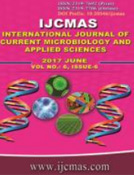


 National Academy of Agricultural Sciences (NAAS)
National Academy of Agricultural Sciences (NAAS)

|
PRINT ISSN : 2319-7692
Online ISSN : 2319-7706 Issues : 12 per year Publisher : Excellent Publishers Email : editorijcmas@gmail.com / submit@ijcmas.com Editor-in-chief: Dr.M.Prakash Index Copernicus ICV 2018: 95.39 NAAS RATING 2020: 5.38 |
Recently, abiotic stress like salinity, drought and temperature are the severe problems to worldwide wheat production, mostly in arid and semiarid areas. A feasible solution is breeding for salt-tolerant cultivars of wheat, while the presence of genetic variation is a prerequisite for genetic improvement. In the present investigation, an experiment was conducted to estimate the nature and magnitude of genetic diversity in improved varieties of bread wheat during Rabi, 2010-11. Total number of 143 exotic and indigenous lines of bread wheat including three checks was apprised in partially reclaimed salt affected soil under late sown and irrigated conditions. The experiment was conducted in Augmented Block Design having 7 blocks of 23 plots each, at Narendra Deva University of Agriculture and Technology, Narendra Nagar (Kumarganj), Faizabad. All the wheat germplam were grouped into twelve clusters by estimating genetic divergence of eleven quantitative traits using the non-hierarchical Euclidean cluster analysis which showed the highest inter-cluster distance between cluster VI and cluster XII. The genotypes having high mean performance for grain yield per plant and several other yield components were found to be concentrated in cluster IV and VI which merit showed due consideration for selection of parents. Thus, crosses between promising lines belonging to cluster pair having higher inter-cluster distances may be attempted for isolating transgressive segregants as these cluster pair were also separated by high inter-cluster distances. The twelve clusters formed in divergence analysis contained genotypes of heterogeneous origin, thereby indicating non-parallelism between genetic and geographic diversity. Therefore, crosses between the members of clusters separated by high inter-cluster distances are likely to throw desirable segregates. This indicated existence of high degree of genetic diversity in the wheat exotic and indigenous lines. Therefore, these exotic and indigenous lines may serve as valuable source for selecting diverse parents for use in hybridization programme.
 |
 |
 |
 |
 |